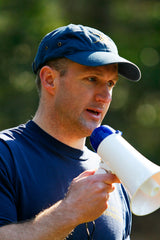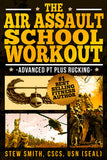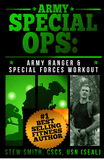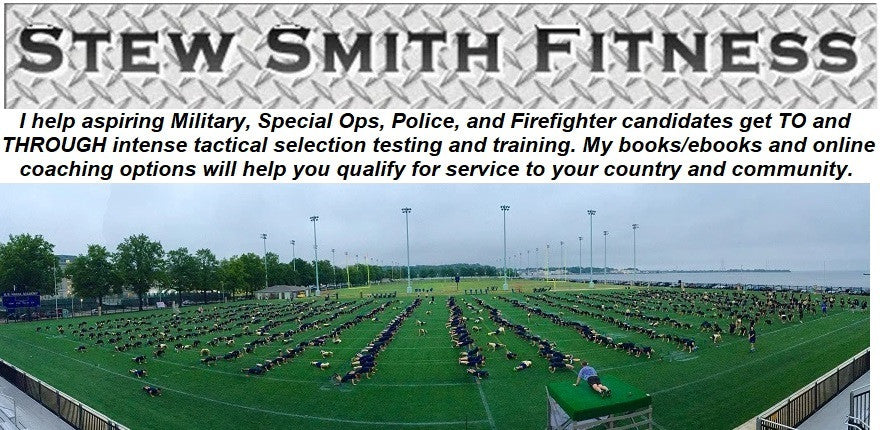
Over the past 20+ years, I have personally trained for / taken, as well as administered countless Navy SEAL / SWCC / Diver Physical Screening Tests (PST). I have created a system that enables both the instructor and student gauge progress as well as make changes to current training programs to quickly increase performance in the PST. If you have never taken a Navy PST, do not think any of your current individual scores will be accomplished as each event has a way of taking reps away from the next event as well as add time to your runs and swims.
Below are four recent PST takers and their scores throughout what I call the "22 events of the Navy SEAL PST". Instead of thinking only of the FIVE main events of the PST (500yd swim, pushups, situps, pullups, 1.5 mile run), I break it down into 22 smaller points to help understand what the student needs the most help with during the PST and his/her training. See Navy SEAL PST Clinic FREE Video link for more information!
500 Yard Swim - Mastering the Combat Swimmer Stroke
The number one way to get faster at swimming is get your technique mastered and your endurance up for 500yd swim. This requires several days per week of swimming so you have to put in the time to make this event easier. The goal to the first event of the PST is to PACE yourself so you are still as fast as possible BUT have plenty left in the tank for the other four events of the test. As you can see from the four students below they all had different experiences in the PST, all tried to pace themselves but they soon found out that building up your endurance is also critical to this test.

*What I look at when giving the PST is the time per 50yds for each of the ten laps as well as the stroke count it takes you to get across 25yd pool. The goal is to get the stroke count down to 5-6 strokes per length and not lose your form throughout the 500yd swim. As you can see a few of the guys need to work on their swimming endurance as once they get tired their form turns poor and they add many strokes per length just making you more tired for the rest of the PST.
|
Lap / Time |
A |
B |
C |
D |
|
1 |
::58 |
::49 (8s/l) |
::42 (6s/l) |
::52 (6s/l) |
|
2 |
2:00 (7 s/l)) |
1:50 |
1:30 |
1:40 |
|
3 |
3:06 |
2:50 |
2:20 |
2:32 |
|
4 |
4:15 |
3:50 (9s/l) |
3:07 (7s/l) |
3:28 |
|
5 SPLIT |
5:20 |
4:45 |
4:00 |
4:20 (7 s/l) |
|
6 |
6:40 (9s/l) |
5:50 |
4:45 |
5:12 |
|
7 |
7:50 |
6:50 (9s/l) |
5:35 |
6:05 |
|
8 |
9:00 (11s/l) |
7:50 |
6:29 (7s/l) |
7:00 |
|
9 |
10:15 |
8:50 |
7:15 |
7:50 (8s/l) |
|
10 |
11:28 (13s/l) |
9:47 (10s/l) |
8:04 (7s/l) |
8:35 |
|
Student A: Started out at a sub 10 min pace for the first 2-3 laps. After 150yds, his stroke count started increasing as well as his 50yd splits. He needs to focus on more 200-250yd timed swims for 4-5 sets to get his endurance up for this distance. He is still learning and it was his first PST. Student B: Started out sub 10min pace as well but was able to maintain it, however the first two laps were actually closer to 8 min pace so he still started out too fast for his level of endurance. He did maintain his stroke count pretty well which helped him keep his 1min lap pace steady through the swim. He now needs to focus on maintaining 50-55 second laps for 10 laps in his workouts to get down to the sub 9 zone in the swim. Student C: Started out at 7-7:30 pace but maintained 45-50 seconds each lap which scored him a nice swim of 8min AND he kept his stroke count to 6-7 the whole 500yds. His endurance is there now if he wants to push faster times in the sub 8 min region he needs to focus on maintaining 45-47 second 50yd swims. Student D: Perfect paced swim for his endurance. He started out at 52 seconds which is an 8:40 pace and ended with 8:35. The 5 lap split was a perfectly on pace for where he finished. Stroke count increased by 2 strokes per length but 1-2 strokes / length is an acceptable increase. |
Tips for Faster Times: 500yd = PACE - 10 x 50yd swim at goal pace – counting strokes per length. When you see your strokes per length start to increase more than 2 strokes per length, make your workouts so you push that particular distance several times (like 5-6 sets). Usually I recommend 1000-1500yds of swimming per swim workout. These workouts maybe 10-15 - 100yd swims, 5-6 200yd swims, or when you get good, you can push 2-3 500yd swims for time.
Even though they call the next section the Strength Section of the PST, it is truly an endurance test. Your ability to do multiple repetitions of each of these exercises without fail has a strength component to it BUT to ace this test you have to be able to take these traditional strength exercises and make it an endurance exercise.
Tips for More Reps: For the Pull-ups, Sit-ups, Pushups, let gravity take you down so do not waste energy slowly letting yourself to the down position - so you are just exerting on the UP movement.
Pushups - Proper stance. Your hands should be about shoulder width apart. Lie on the floor with your hands even with your chest and hands just outside shoulder width. Too many people place their hands too high or too low, which will weaken your push-ups tremendously. Touch your chest to your partners fist who is counting your reps for you. If you have no partner, get a water bottle the size of a fist (3-4inches) off the floor to touch your chest on.
| A | B | C | D |
|
59 |
50 |
79 |
80 |
|
Student A: Had perfect form but was going down too slow / controlled to maintain a 2 min pushup set. Student B: Has always been weak at pushups and actually improving from previous PST, so his job is to keep doing pushups past the 1 min mark where he failed and dropped to his knees during this PST. Perfect pace if he builds up his endurance for another minute. Student C and D: Both did OK but need to build up their reps to push the 100+ zone for a competitive SEAL slot. Usually this only takes a few weeks of doing pushup workouts 3 times a week (every other day) in the 2 min timed set range. |
PS - if you ever start shaking uncontrollably during the final half minute of your pushup test, DO NOT try to get any more reps. When you are shaking you are wasting A LOT of energy that you will need for the remaining exercises of the test AND you will likely not even get 1-2 pushups once you start shaking. It is recommended to just fall on your chest / knees and your test is done. Related Articles: Pushup Push Workout, Pushups
 Sit-ups - Place your feet flat on the floor and raise your knees. It is best to start out with the heels of your feet about 12-18 inches from your rump.
Sit-ups - Place your feet flat on the floor and raise your knees. It is best to start out with the heels of your feet about 12-18 inches from your rump.
Situps or curlups - For the Navy PST - lie on your back with your arms crossed over your chest, keeping your knees slightly bent. Raise your upper body off the floor by flexing your abdominal muscles. Touch your elbows to your thighs and repeat. During the PFT, someone will be counting and holding your feet for you.
PACE YOURSELF: The most important thing is to pace your situps. Too many times people start out too fast and do about 30-40 in the first 30 seconds and not being able to get 30-40 in the next 1:30 in a 2:00 test. That tells me that you started out too fast. If your goal is 80-100 in a 2:00 period, you should pace yourself at 20-25 in 30 seconds and 40-50 in 1:00...etc.
| A | B | C | D |
|
::30 / 33 |
20 |
28 |
25 |
|
1:00 / 58 |
34 |
50 |
40 |
|
1:30 / 80 |
50 |
67 |
60 |
|
2:00 / 90 |
55 |
87 |
78 |
|
Student A: After 1 min, student A was on pace to hit 115-120 situps in 2 minutes but as you can see he dropped and just got another 30 reps vs 60 reps he was pacing. If he drops his ::30 pace to 25, then 50 at 1 min, he will see 95-100 situps as he will be able to handle the slower pace for longer. Student B: He is improving still but his pace dropped off after ::30. He is working his sets so he can muscle memory 20 reps in ::30 for all 2 minutes. His next goal is 80 in 2 min. Student C and D: Both petered out after 30-60 seconds and could not maintain the pace they started. They both need to add 1 min situps sets into their workouts of 50-55 situps per minute to push the next range of 100+ situps. |
A Few More Reps Tip: 1 - When you feel like you are failing. Slide your butt back 2-3 inches and you will change the angle at which you do your situps and find yourself able to get 5-10 more if you have the time left. For more info on workout ideas to ace the situps see related article - Proper Situps
Pull-ups - The Proper Pull-up (regular grip) - Grab the pull-up bar with your hands placed about shoulder width apart and your palms facing away from you. Pull yourself upward until your chin is over the bar and complete the exercise by slowly moving to the hanging position.
| A | B | C | D |
|
12 |
12 |
20 |
16 |
|
Student A,B,C,D - All had proper form for pullups, just some were better than others. takes practice doing pullups, negatives, pulldowns, rows, and other PULLING exercises to get better at pullups. Student C as he started to come close to failing looked up and arched his back for the last few reps to make sure his back was getting into the exercise vs. just his arms. |
The transition to the RUN: After you perform maximum repetition sets with your upper body muscles, your heart has forced blood to the arms, shoulders, and torso leaving you very “pumped up”. Running like this can be difficult because the heart has to now pump the blood from your arms and torso down to your legs and, of course, oxygenate the blood repetitively.
When blood is “stuck” in the upper body as it is after a maximum repetition PT test, your heart pumps harder than normal, which can throw off your known pace (muscle memory) that you have trained to maintain for your run. Your breathing is more rapid, your heartbeat is therefore more rapid, your arms swing is more stiff than fluid and relaxed, and your legs are burning for oxygenated blood. This will leave many to say at the end of the run, “I felt OK after the first two laps, but the first half mile about killed me.”
Here is the answer to this problem:
After you perform the PT test, take the time in between the upper body exercises to stretch the arms, chest, shoulders, stomach and lower back. Then run for about 2-3 minutes at an easy pace to get the blood down toward your legs. Finally, take about 3-5 minutes to stretch your legs. Keep shaking the arms, throughout the time in between the PT and run, to loosen up.
Related Article: PST Transition
10 MIN REST - focus on transition from swim / PT during this 10 min interval.
Focus on PACE with the 1.5 mile run. After the swim and PT portions of the test, usually the run turns into a gut check. I find that having sipped some Gatorade or had some extra sugar in my body will help with that final push of energy needed to go anaerobic in the run for the best time. After you have transitioned from the PT portion, focus on steady running pace, inhales/exhales, and arm swings to work through the next 1.5 miles of running. If done in the heat, make sure you have properly hydrated prior to the PST, but also sipped enough water / electrolytes / sugar so you are at your best.
| A | B | C | D |
|
1 lap / 1:40 |
1:32 |
1:30 |
1:35 |
|
2 lap / 3:30 |
3:08 |
3:00 |
3:20 |
|
3 lap / 5:15 |
4:50 |
4:30 |
5:15 |
|
4 lap / 7:00 |
6:40 |
6:00 |
7:06 |
|
5 lap / 8:45 |
8:00 |
7:33 |
8:58 |
|
6 lap / 10:40 |
9:37 |
8:57 |
10:40 |
|
Student A: Had a perfect 7 min mile pace for the first mile but dropped 15 seconds in the 5th lap. Focusing on faster mile plus runs will help push over the endurance drop. Student B: Had a 6-6:30 mile pace throughout the run and kept it steady for one of his best timed runs ever. Work on maintaining 1:30 quarters to get to the 9 flat 1.5 mile run. Student C: Perfect 6 min mile pace throughout. As with his swimming, he nailed 6 min mile pace for 1.5 mile and had enough juice to speed up 6 seconds on the last lap to break 9 min. Student D: Started off at 6 min mile pace and slowed down to 7 min mile pace. Needs to work on 1.30 quarters and 3 min half mile intervals running |
Related Articles: Evolution of Running - Technique, Run and Leg PT, Drop Mile Pace
This is how I have been breaking down the PST for years so students can have a better understanding of where in the test they are failing and how to get over these sticking points. The best way to get better at this test is to actually test yourself several times. This PST is YOUR entrance exam, so take it seriously. NEVER think you can score this many points or run so fast because if you have not taken this test as it is given, then you will likely be disappointed in how you perform on game day.
Grading of the PST: There is an actual grade for the PST - for more information see Article
Send me an email and I may post it up as an article next week. You can contact me at stew@stewsmith.com.
Assess Yourself Before Your Wreck Yourself
Learn how to assess yourself as a candidate throughout the process of preparing to get TO and THROUGH the training. Not just as an initial assessment, but this chart can help you see where you meet up on the spectrum of training that will place you in the top 25% of candidates in spec ops selection programs. See Assessment tool article and video to help.
Related Articles:
Swimming and Treading - Spec Ops Prep
Dude - You Are Not In Swimming Shape
Better Runs and Swims on the PST
Classic PST Week of Training - Pyramid, Super Sets, Max Rep Sets
Spec Ops Candidates – Is This Your Story?
Be a Better Recruit / Candidate
Spec Ops Prep – One Stop Shop Research Article
Don’t Set a Timeline to Join - Set a Performance Starting Line
Asking Great Questions if You Need Assistance
What is StewSmithFitness.com – Specific Training for Tactical Professions
Complete List of Books, eBooks, Training Programs
But see WHICH PROGRAM IS RIGHT FOR ME?

Who is Stew Smith? Coach, Trainer, Author, Podcaster: I'm the former Navy SEAL that special ops candidates go to for books, ebooks and online coaching to prepare themselves to get to and through intense tactical assessment and selection programs and qualify for service in their chosen tactical profession. See More at StewSmithFitness.com
Where to Find More Information About Optimal Performance Training Programs
When you start training again, consider the seasonal tactical fitness model. I call it A WAY to train and obviously not the only way to train. But it offers the opportunity to never neglect your weaknesses, helps with flexibility and mobility, but will also put you at a level of physical abilities where you are happy with your overall ability to just about anything. We have a systems where the seasons dictate our training. When it is nicer outside, we tend to run and do more calisthenics. When it is colder and not so nice, we lift more, run, less, and still maintain our outdoor activities with shorter runs and rucks. Check it out: Seasonal Tactical Fitness Periodization System.
My most recent programs that walk you through these four cycles with 12 weeks of each season in two programs.
These Seasonal Tactical Fitness BLOCK Periodization programs will walk you through 4 x 4 weeks cycles with 16 weeks of each season in two programs. (32 total weeks)

The Specific Military / Special Ops Physical Fitness Workouts Where Optimal Performance Will Be Tested Each Day
Navy SEAL Workout Phase 1
Navy SEAL Workout Phase 2 - 3
Navy SEAL Workout Phase 4 Grinder PT
Navy SWCC Workout



Army PFT Workout (Prep For Rucking, OPAT, ACFT)
Army Special Forces / Ranger Workout
Army Air Assault School Workout
Army Airborne Workout





Advanced Running Program - Special Ops Supplement Plan
USMC RECON / MarSOC Workout
USMC OCS / TBS Workout
USMC IST and PFT
The Combat Conditioning Workout
Air Force PJ / CCT Workout Battlefield Airman Prep Course
The UBRR Upper Body Round Robin Workout / Spec Ops version
The Coast Guard Rescue Swimmer / Navy SAR Workout
The Service Academy Workout (West Point, Navy, Air Force Academy)
The Navy, Air Force, Marine Corp Boot Camp Workout
The Law Enforcement Physical Fitness Workouts
The FBI Academy Workout | FBI Workout Vol 2
The DEA Workout
The FLETC Workout - Ace the PEB
The PFT Bible: Pushups, Sit-ups, 1.5 Mile Run
The Fire Fighter Workout - Ace the CPAT
Online Coaching Options
Online PT CLUB - Weekly Workouts created personally for you.
New Member's Only Content / Services Program!
If you want access to years worth of workouts, many of the top eBOOKs, favorite workouts of the week, free fitness APP, closed Facebook Group, video / picture library of exercises, and more access to LIVE Q/A sessions check out the Stew Smith Fitness Members Section.
The dashboard below has the links to all the information, archives, videos, and links to workouts, podcasts, live Q and A lessons.
Consider this! - A Membership Program and Gain Access to Exclusive Content
(click for Fitness Club Dashboard - members only)
Questions? Just email - Stew@StewSmith.com
At StewSmith.com - List of Products and Services
- FREE Articles
- Podcasts and Swimming Videos (Youtube, TikTok, Instagram)
- eBooks
- Books and eBooks in PRINT
- Stew Smith Fitness Club membership site
- Online Coaching
Stew Smith Fitness

















